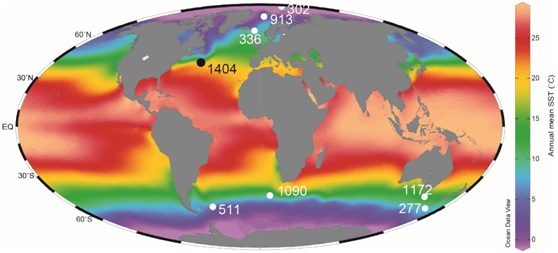
Scientists from the Institute of Earth Environment (IEE) of the Chinese Academy of Sciences, along with their collaborators, reconstructed sea surface temperature (SST) changes from 43 million years ago (Ma) to 18 Ma. The results showed that North Atlantic SST did not immediately cool down when Antarctic continental ice started to develop around 34 Ma.
The Paleogene (65-23 Ma) is an important period in Earth’s climate history. Existing incomplete temperature records suggest that the climate was exceptionally warm. For a long time, Earth’s continents were ice-free.
During the Eocene-Oligocene Transition (EOT) around 34 Ma, permanent continental ice sheets started to occur on Antarctic, after the long-term gradual global cooling during the Eocene.
The Atlantic Meridional Overturning Circulation (AMOC), which flows from the South Atlantic to the North Atlantic, across the Equator, at the surface ocean and returns to the Southern Ocean at the deep ocean, plays an important role in abrupt climatic changes.
Therefore, the controlling factors on the AMOC and the projection of future AMOC evolution have been a hot topic in oceanography and global climate change studies.
However, it remains controversial that whether it's the deep water formation in the North Atlantic or the upwelling in the Southern Ocean plays a more important role in facilitating the AMOC. It also remains unclear how the early AMOC evolved into its present form.
The researchers reconstructed SST changes, for the first time, over a long 25-million-years period, from 43 Ma to 18 Ma, utilizing the newly retrieved 200 m sediment core from the Newfoundland Ridge in the North Atlantic Ocean in 2012 by Integrated Ocean Discovery Program (IODP), which includes climate information from the critical EOT interval.
The SST record confirmed the exceptional warmth during the Paleogene period. They found that the 25°C isotherm was positioned ~15° latitude (>1,500 km) to the north of its modern position. The record showed that SST fluctuations during most of the studied period were consistent with deep water temperature changes, as indicated by the oxygen isotopes of benthic calcites.
However, the record also demonstrated an important anomaly. Over a 2-million-year period (~34-32 Ma) around the EOT, North Atlantic Ocean showed little contemporaneous surface cooling associated with the Antarctic ice sheets formation when the Southern Ocean appeared to have cooled substantially.
The distinct decoupling of temperature changes between hemispheres suggested that changes in ocean circulation and meridional heat transport were important across the EOT, perhaps triggering the development of modern-like AMOC.
The study entitled "Transient temperature asymmetry between hemispheres in the Palaeogene Atlantic Ocean" was published in Nature Geoscience.

Location map for this study, with present study site indicated with black and locations of previous studies indicated with white. (Image by LIU Zhonghui et al.)

86-10-68597521 (day)
86-10-68597289 (night)

86-10-68511095 (day)
86-10-68512458 (night)

cas_en@cas.cn

52 Sanlihe Rd., Xicheng District,
Beijing, China (100864)

